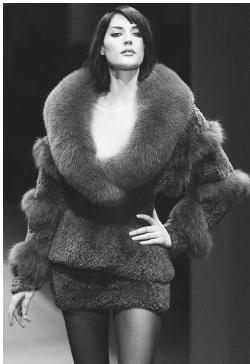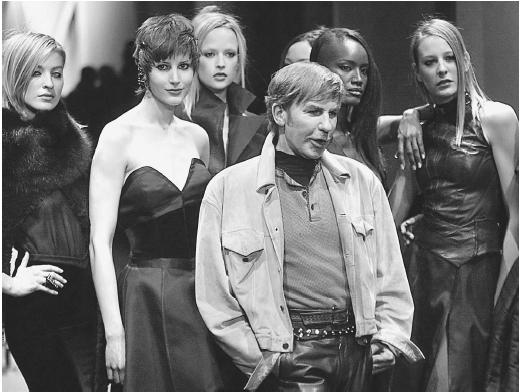Claude Montana - Fashion Designer Encyclopedia
French designer
Born: Paris, 29 June 1949. Education: Studied chemistry and law. Family: Married Wallis Franken, 1993 (died 1996). Career: Freelance jewelry designer, London, 1971-72; designer, with Michelle Costas, ready-to-wear and accessories line for Idéal-Cuir, Paris, 1973; assistant designer, 1973, and head designer, 1974, MacDouglas Leathers, Paris; freelance designer, Complice, Ferrer y Sentis Knitwear,

Publications
On MONTANA:
Books
Hayden Gallery, Massachusetts Institute of Technology, Intimate Architecture: Contemporary Clothing Design [exhibition catalogue], Cambridge, 1982.
Perschetz, Lois, ed., W, The Designing Life, New York, 1987.
Articles
Talley, André Leon, "The State of Montana," in WWD, 13 March 1978.
McCarthy, Patrick, "Claude Reigns," in WWD, 4 September 1979.
"Paris Advance: Claude Montana," in WWD, 2 October 1980.
Brantley, Ben, "I, Claude," in WWD, 18 May 1984.
Brampton, Sally, "La régle du jeu," in the Observer (London), 5 May 1985.
Filmer, Denny, "Claude Montana," in Cosmopolitan (London), October 1988.
Knafo, Robert, "Claude Montana," in Connoisseur, November 1988.
Brubach, Holly, "Selling Montana," in the New Yorker, 23 January 1989.
Petkanas, Christopher, "Chez Claude," in Harper's Bazaar (New York), June 1989.
Gross, Michael, "The Great State of Montana," in New York, 31 July 1989.
"Montana: Then and Now," in WWD, 19 October 1989.
Thim, Dennis, "The New State of Montana," in WWD, 29 May 1990.
Vernesse, Francine, "Viva Montana," in Elle (Paris), 13 August 1990.
Mulvagh, Jane, "Lanvin c'est moi," in the Sunday Times Magazine (London), 4 November 1990.
Spindler, Amy M., "Claude's New Adventure," in WWD, 26 February 1992.
James, Laurie, "The State of Montana," in Harper's Bazaar, October 1992.
Schiro, Anne-Marie, "Photogenic, But Out of Focus," in the New York Times, 20 March 1995.
"Montana Leaves GFT for Mendes," in WWD, 9 May 1996.
Weisman, Katherine, "Montana Leather Accessories Lines to Debut," in WWD, 9 September 1996.

Wilson, Eric, "Trademark Dispute Pits State of Montana vs. Claude Montana," in WWD, 21 March 1997.
——, "Ortenbergs Back Little Guy in Montana Wars," in WWD, 22 April 1997.
Aktar, Alev, "Just Me: Montana's Next Fragrance Foray," in WWD, 27 June 1997.
Raper, Sarah, and Katherine Weisman, "Claude Montana Files for Credit Protection; Restructuring Planned," in WWD, 19 November 1997.
Pogoda, Dianne M., "The Year in Fashion," in WWD, 15 December 1997.
Raper, Sarah, "Montana Has Possible Buyer in Ex-Ricci VP," in WWD, 18 March 1998.
——, "Claude Montana Hits Comeback Trail," in WWD, 13 April 1998.
Weisman, Kathering, "Montana's New Blu," in WWD, 1 October 1998.
"…Claude Montana Did Sexy Leathers and Glam Furs…," in WWD, 19 March 2001.
"Fresh and Fragrant 'Blu' Breath of Air," in the New Straits Times, 24 May 2001.
***
In the late 1970s and 1980s Claude Montana was known for an outré silhouette and commanding sense of aggression that made him both enfant terrible in a cultural sense and yet fashion's most devoted adherent in design. Padded shoulders and leathers seemed to some observers a misogynist's view of women in the manner of a cartoon. To others, however, the same style renewed the shoulder-accented horizontal of Constructivism, or even the influence of Balenciaga's surgically acute cut. Little wonder, then, that Montana said in an interview in 1989, "I'm like a battlefield inside, a mass of contradictions." More than ever, Montana has proved in the late 1980s and 1990s how contradictory and how complex his style is, incapable of the kinds of knee-jerk reactions that many critics had initially. Few designers have been as virulently attacked as Montana has, sometimes for "gay-clone" proclivities to leather, for supposed misogyny, for impractical clothing, for excessive accoutrements. Leather jackets borrowed from menswear—bikers and the military—caused strong controversy in the American press and market in the 1980s when Montana appropriated them. A decade later, Ralph Lauren, Donna Karan, Calvin Klein, and Byron Lars were working with similar looks to no protest (and Saint Laurent had long borrowed from the male wardrobe to only mild demurral).
Few designers today can be equally admired for the surety of cut, the sensuousness of appearance, the femininity that is beneath the bold forms, the luxurious seductions of fabrics more varied than leather alone, and the continuous and consummate mastery of a fashion design that always plays between the abstract forms of art and the conventions of clothing. Indeed, Constructivism is a strong influence on Montana's work. Top-heavy geometry twirling into a narrow skirt or pencil-thin trousers was not commonplace until Montana offered the option. Reductive by nature, Montana has vacillated in terms of accessorizing, particularly in the mid-1980s, but by the 1990s he clearly preferred an austerity about clothing, approximating the linear probity and arc-based sculptural form. Like Constructivist drawings for the stage, Montana's designs come to life in the animation of gyrating proportions, often with exaggerated shoulders or collars, almost invariably with a very narrow waist, and the spin of a peplum over a narrow skirt. Cocoon coats could seem to be the nimbus of abstraction; spiralling line, alternately clinging to the body and spinning away, seemed a gesture of whole cloth, unpieced.
Montana's principal aesthetic contribution is silhouette; nonetheless, his materials, beginning historically with leather, and his color palette are beautiful and sensuous. What became the power look in women's clothing in the mid-1980s is derived from Montana's aesthetic, so persuasive was it as an option for assertive presence without sacrifice of the female form. Based on circuiting spirals and a few strong lines realized on the body, Montana's aesthetic was described by some critics as being too Space Age or futuristic, but recognized by its advocates for its invocation of the principles of Futurist abstraction. Moreover, after a signal collection for fall-winter 1984, in which Montana toned down the most extreme aspects of his style, he remained true to his aesthetic principles and interests, demonstrating that they were not merely the radical forms they had seemed at first, but the fundamental forms that fashion had known since Thayatt and Exter, Adrian and Balenciaga. As early as 1979, when many might have dismissed him as an iconoclast, Montana admitted to André Leon Talley of his admiration for Vionnet and Madame Grés, likewise two designers of utmost simplicity of form ( Women's Wear Daily, 13 March 1978).
What had been extreme now seems pure. Even in that convention, Montana has emulated avant-garde art. As an artist-designer, he sustains his own predilections. For example, the gargantuan shoulders are reduced in the late 1980s and great, oversized collars keep the outspoken gesture to the top. Robert Knafo ( Connoisseur, November 1988) describes that transition: "casting out the sharp-shouldered, fearsomely assertive Montana woman, installing in her place a mellower, softer-edged, more romantic figure, although no less self-assured." Indeed, it is some of the referentiality of fashion—association we make with clothing types and image—that has attributed the controversial profile to Montana as a designer. More importantly, he has been a steadfast practitioner of a kind of isolated, non-referential abstraction, obdurately and passionately and compellingly exploring fashion at its most distinct cut. Montana's design survival as a classic figure and a model with lasting impact on other advanced designers in modern fashion attests to that design primacy and perseverance.
After his Lanvin stint, Montana maintained his precise, inimitable approach to fashion. His fall 1995 Paris womenswear collection was presented in stunning, futuristic white. Women's Wear Daily (17 October 1995) applauded the line's "sharp edges, swirling seams and strict silhouettes,"concluding "nobody beats Montana for his precision tailoring." The following year Montana moved the licensing of his two prominent womenswear lines, Montana Femme and State of Montana, from Gruppo GFT to French fashion firm Groupe Mendes. Montana menswear, however, remained with GFT. Additionally in 1996 Montana introduced a new leather collection including handbags, belts, travel bags, and other smaller accessories.
Unfortunately for Montana, brewing legal battles overshadowed his fashion contributions. The imbroglio stemmed from a 1995 tiff with a small firm named Montana Knits, which sought to trademark its name. Claude objected, having already trademarked his apparel lines (Montana, Claude Montana, and State of Montana), and believing Montana Knits would confuse buyers. The owners of Montana Knits, Tom and Ann Doolings, decided to take Claude to court over the matter. Suddenly, it was a cause célébre, with high profile fashion icons like Liz Claiborne championing the underdog Doolings. The case was decided in favor of the Doolings; Montana then subsequently renamed his diffusion line, State of Montana, to Montana White Label.
If the lawsuit was troubling for Montana, what occurred on its heels was much more vexing: his firm was forced to seek protection from creditors in 1997 after several years of sliding sales, setbacks, and just plain bad luck. His woes had included lower margins after switching his Japanese licensee, losing prominent retailers Bloomingdale's and Henri Bendel, and being forced to close several stores for underperformance. The Montana name and the designer's skills, however, were never in question; he was still roundly praised by buyers and critics alike.
Montana finally decided it was time to sell, a decision many of his fellow designers had faced. He told Women's Wear Daily (12 December 1997), "There comes a moment in your life when you say, 'Now, what really interests me is my work and creating.' And so I'm ready now to open up…to an investor with whom I get along, and with whom I share the same ideas about future strategy." That investor turned out to be Jacques Berger, formerly of Nina Ricci, and two partners who paid $670,000 for 51-percent of the struggling fashion firm. Ironically, part of the agreement called for Montana to give up the rights to his name, something he had fought so vehemently for in the past. The designer would, however, maintain the right to design for the house for another ten years.
Montana seemed happy with his prospects, "This is going to give me much more freedom to travel, to sit down and talk with others in the studio about designs," he told Women's Wear Daily (13 April 1998). "Isolation is not very healthy for creativity…. In the end, my biggest role hasn't really changed," Montana explained, "I'm the artistic director for the house and now I will have more energy to throw into my work. That should be stimulating for everybody."
Free from the pressures of running a business, Montana rebounded quickly and unveiled Montana Blu, a younger, hipper collection for women in late 1998. The line seemed to stem from Montana's passion for contemporary art. "Sculpture and painting are inexhaustible inspiration sources," he noted in a biographical sketch at his website. In Montana Blu he has created perhaps the most profound designs bearing his signature; it was successful enough to spawn its own fragrance in 2001, while his signature line was praised by Women's Wear Daily (19 March 2001), "Whatever the Claude Montana collection should be, whatever it could be or once was, for fall, the designer stuck to stuff he knows well—sexy leathers and glamorous furs."
—Richard Martin
Nelly Rhodes